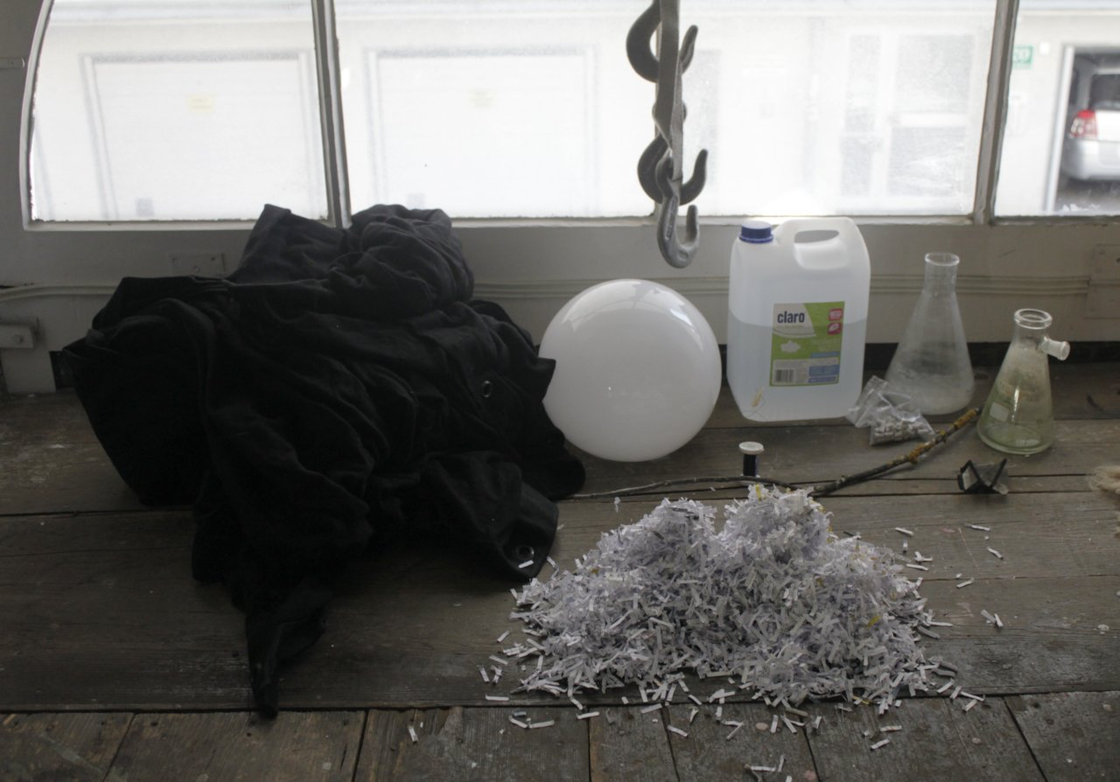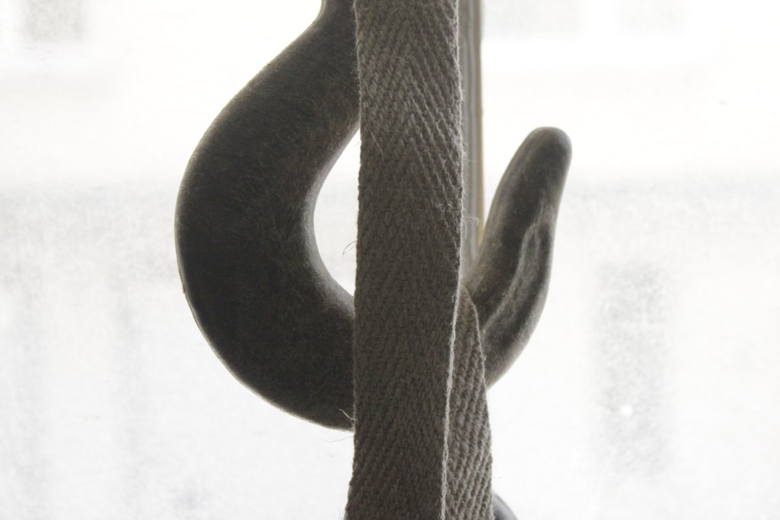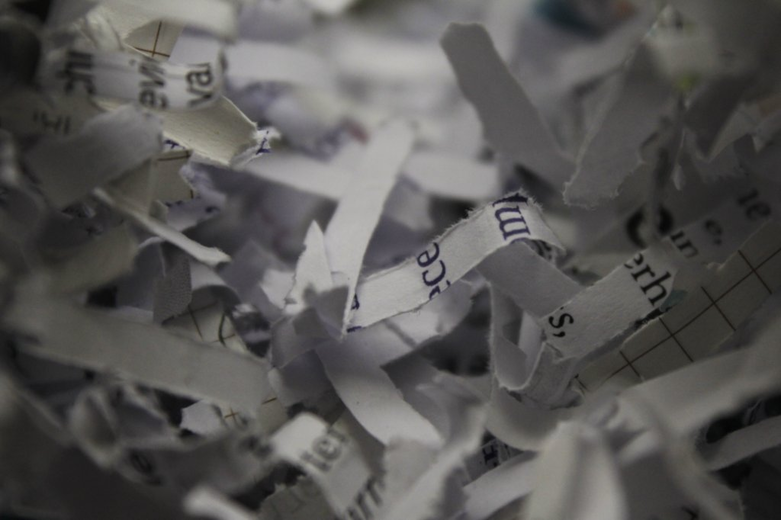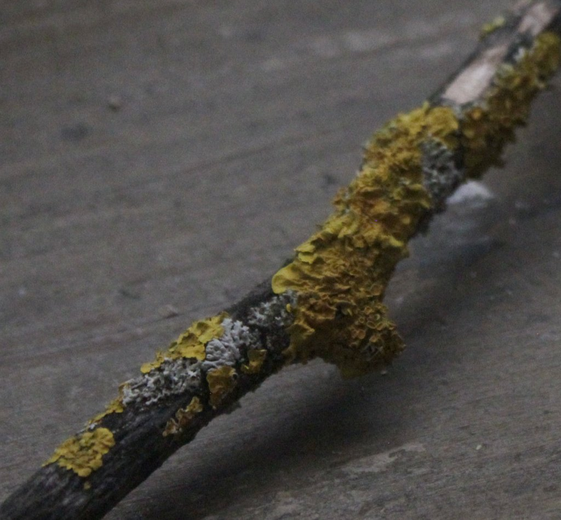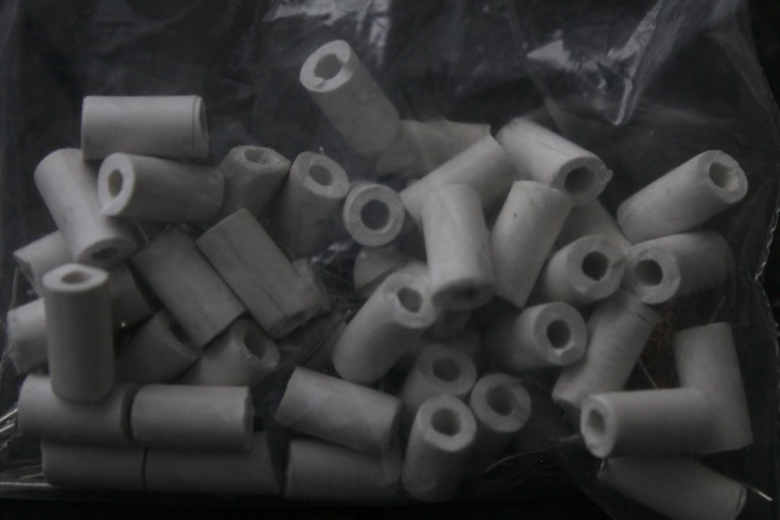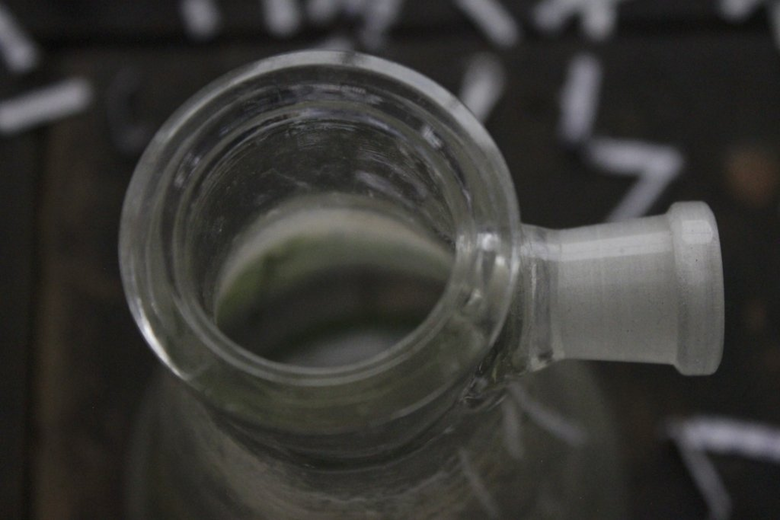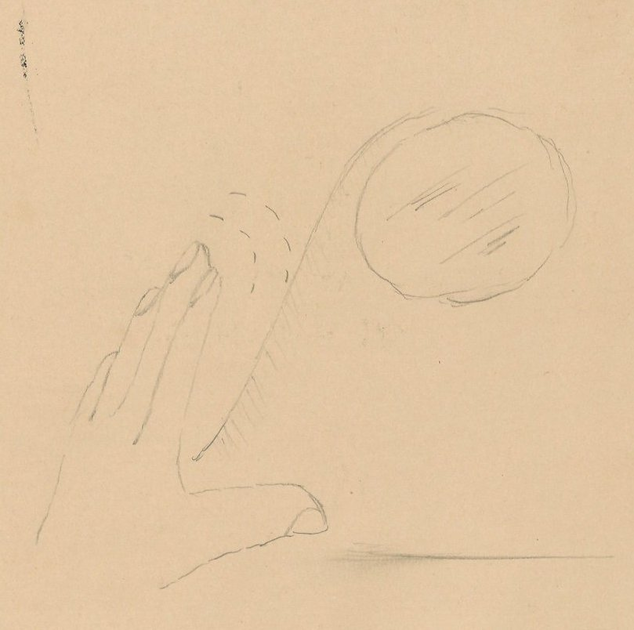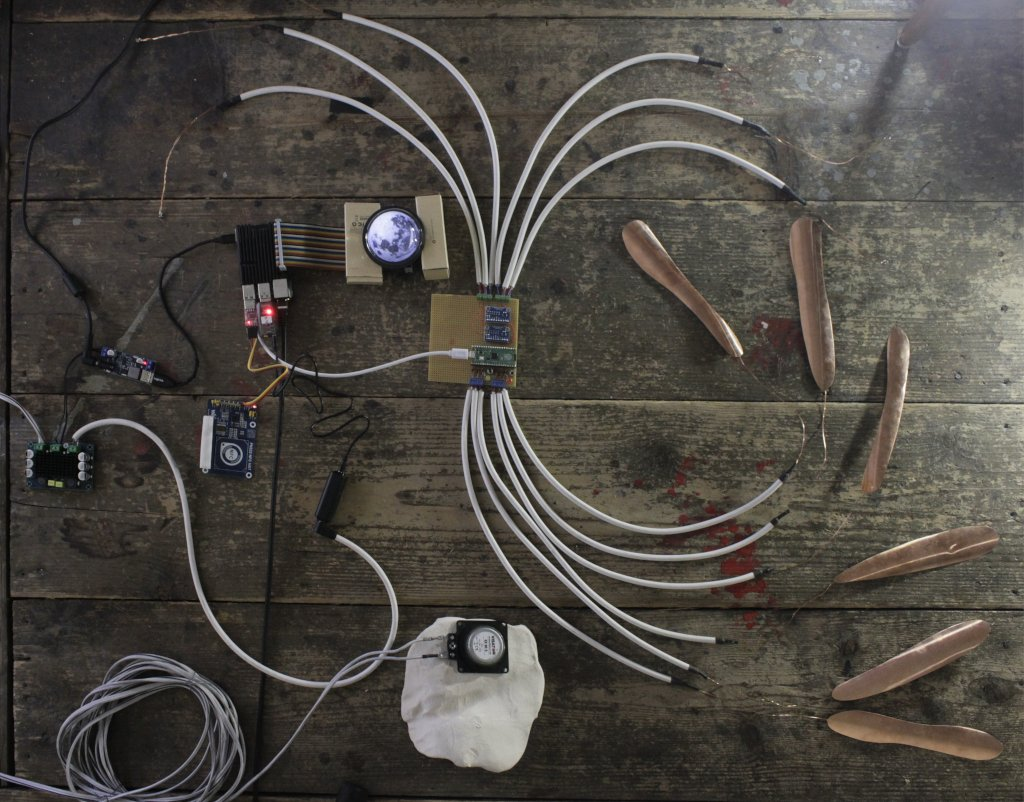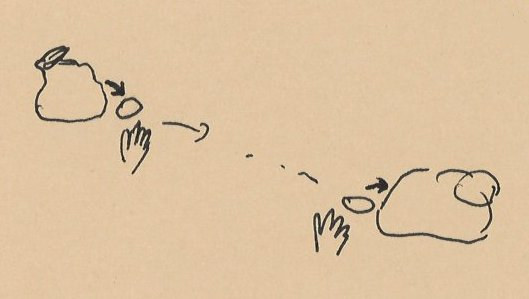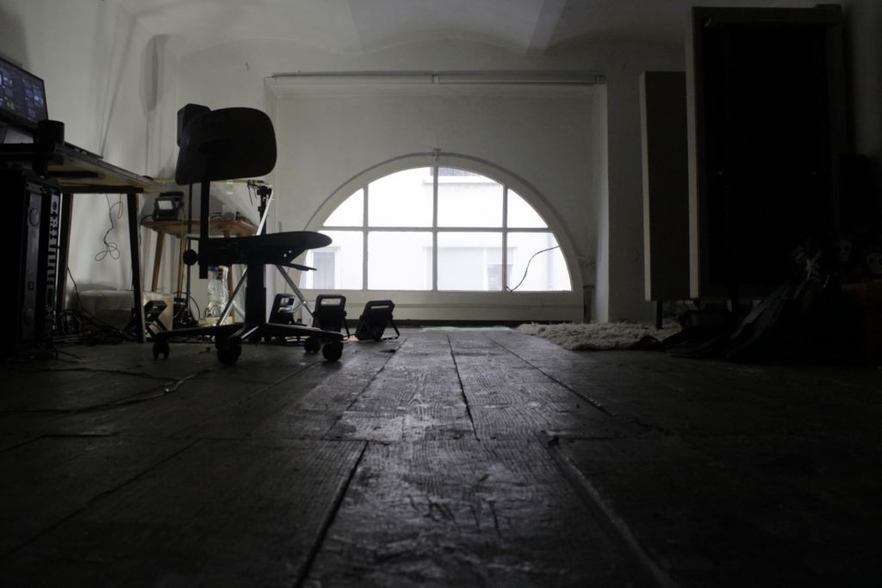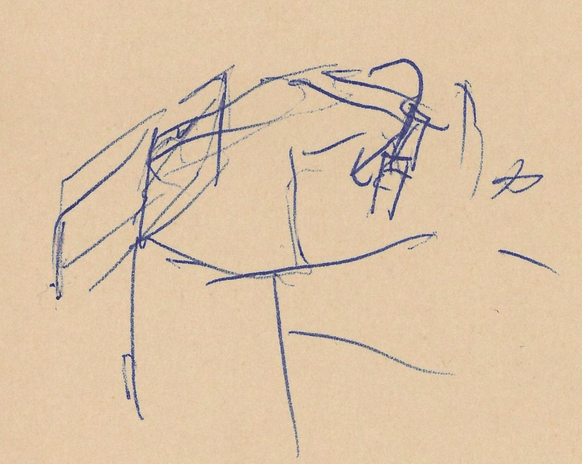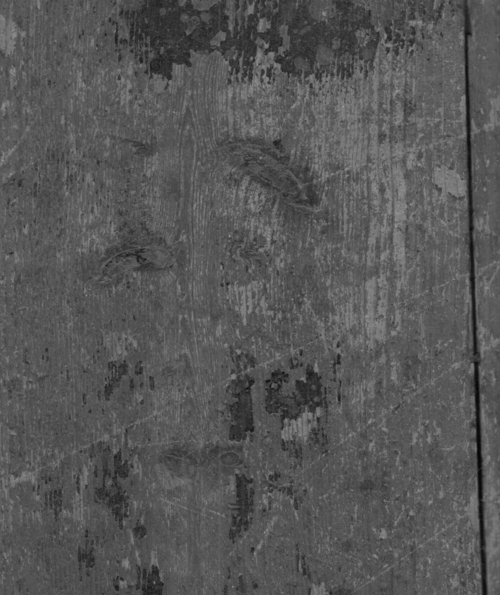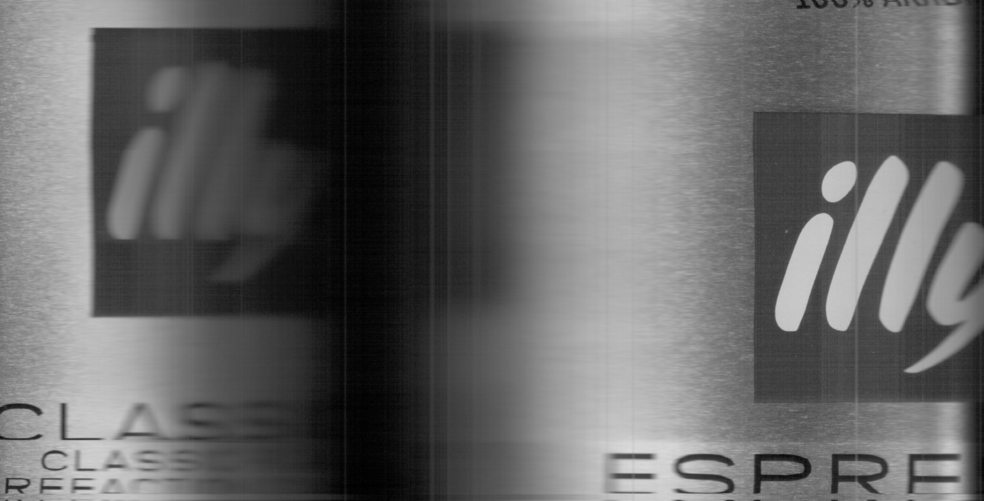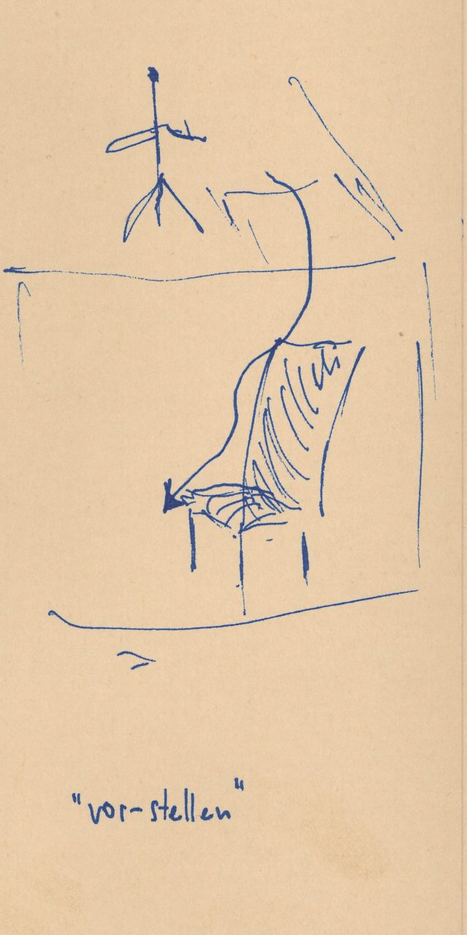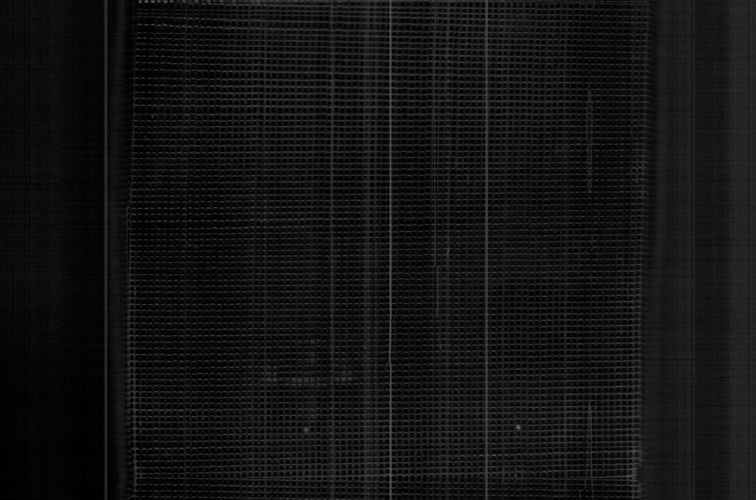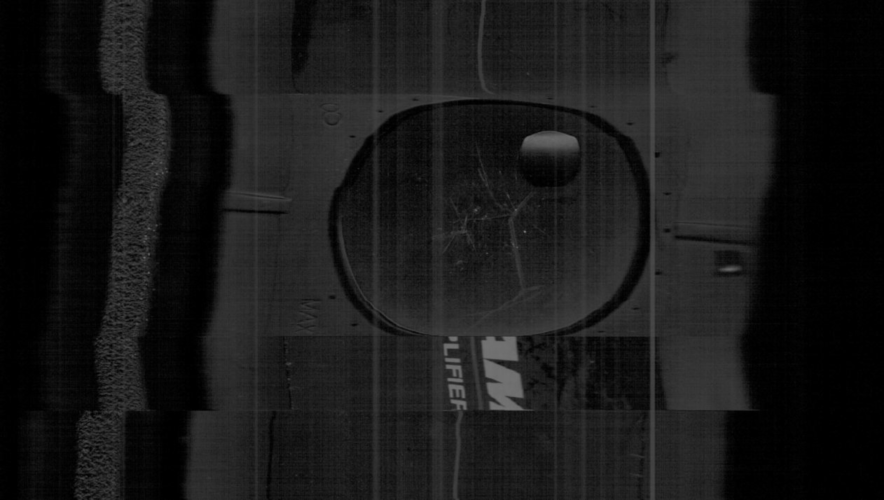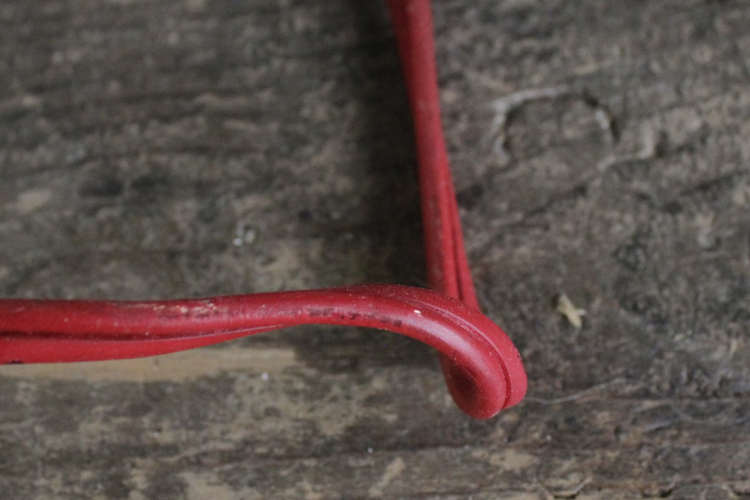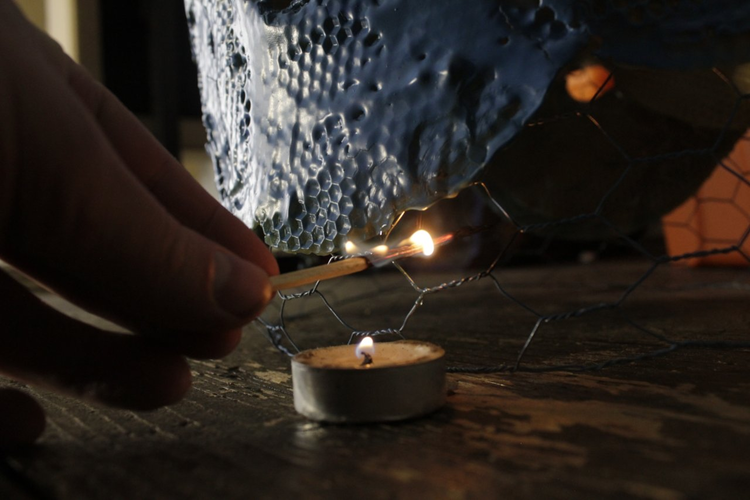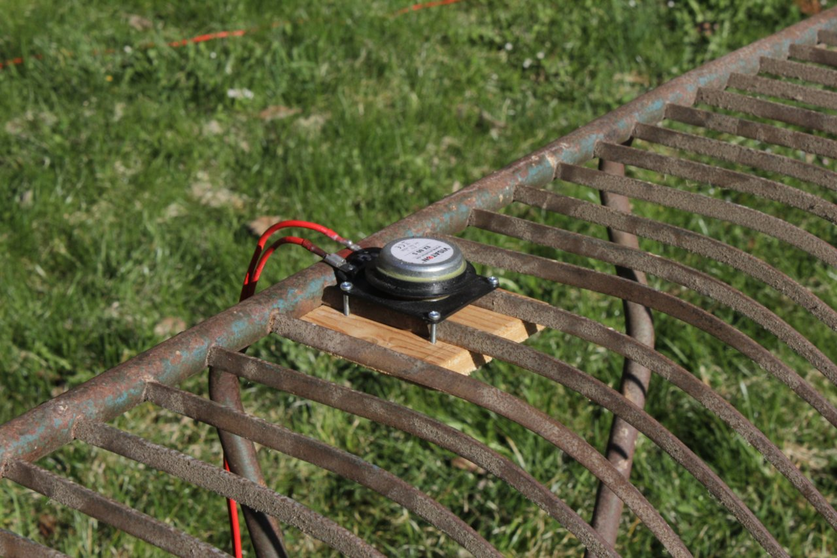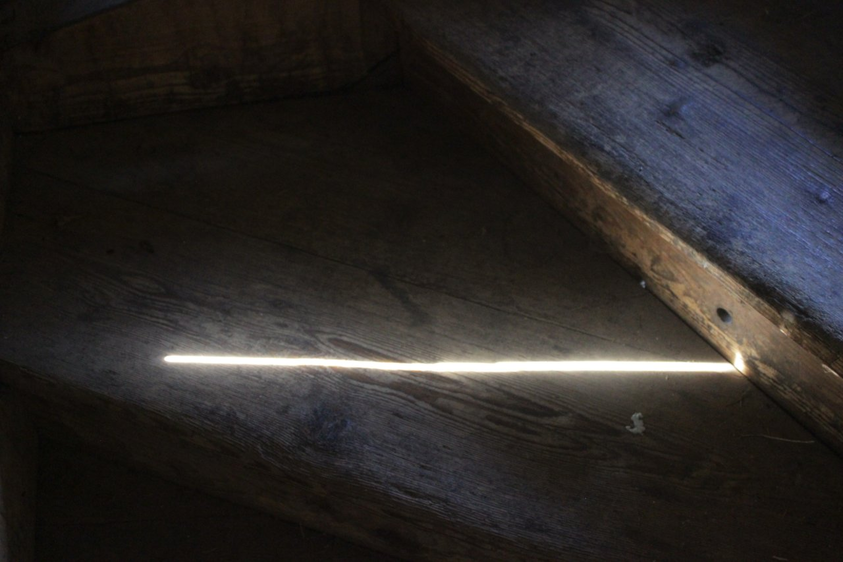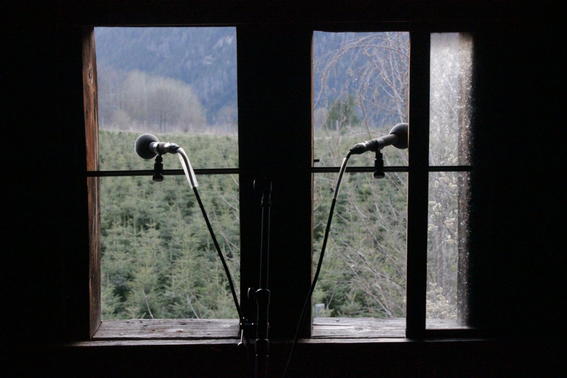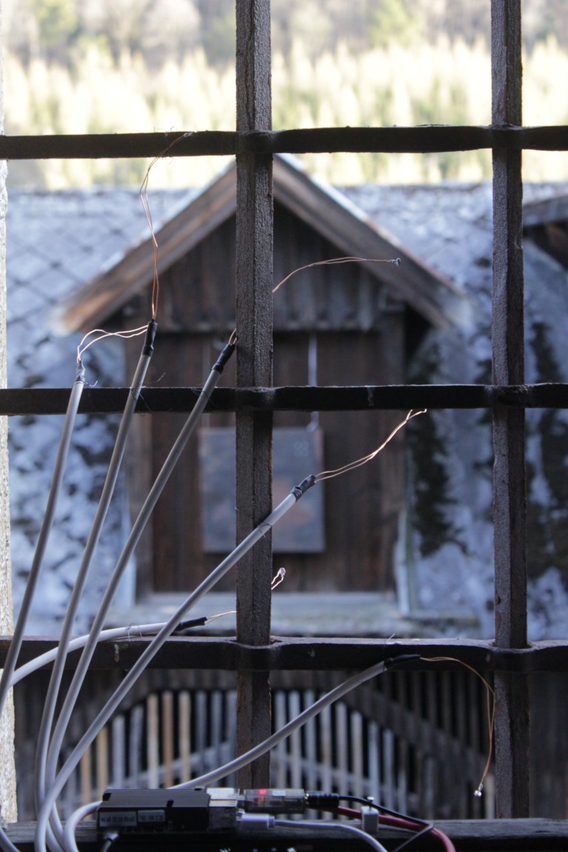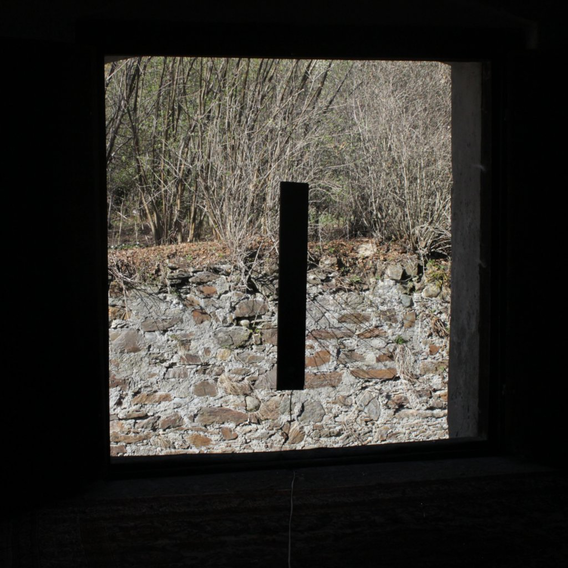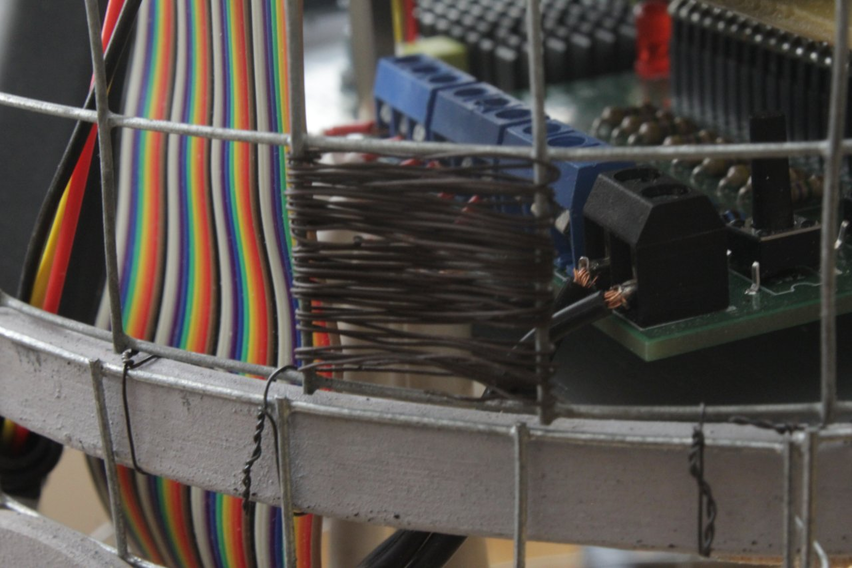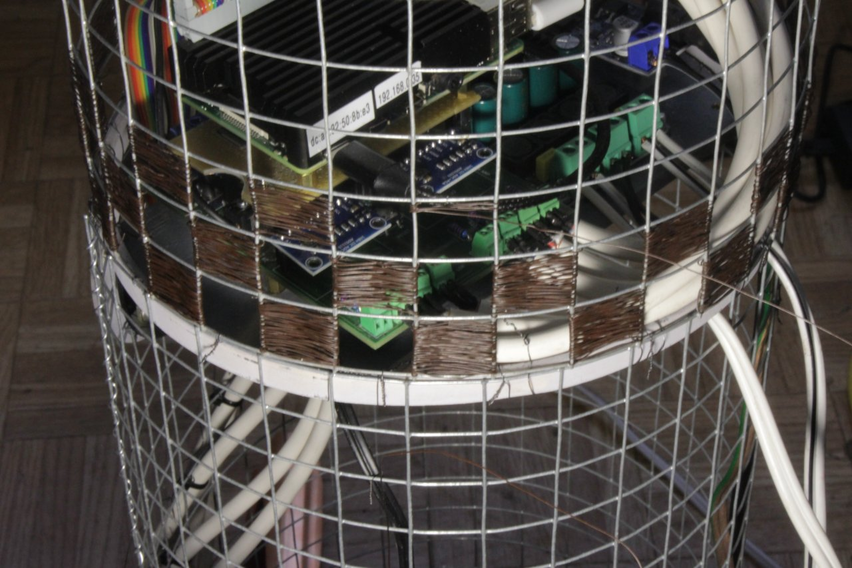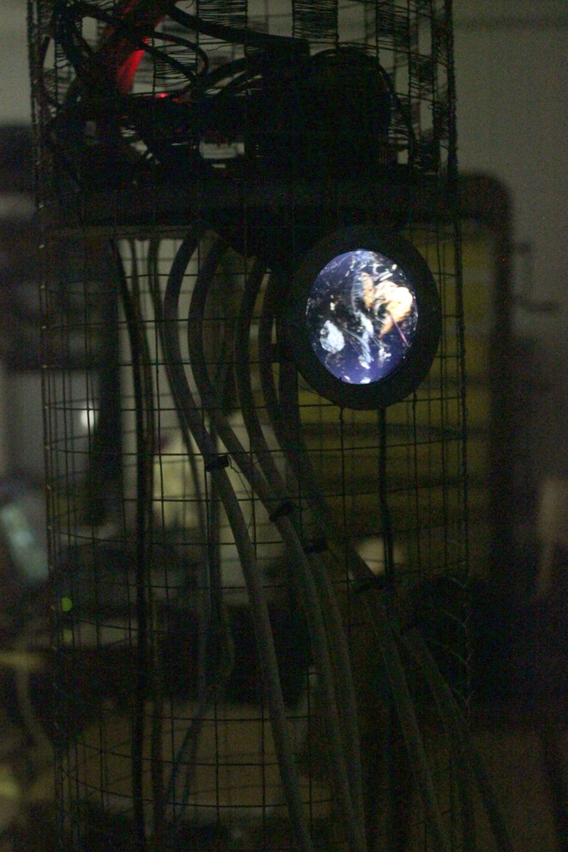{hhr 220327}
Black molton with suspension eyelets. Perhaps to cover or drape something (perform magic), or to create a surface.
Distilled water. I think you can submerse electronical and conductive things without creating a short circuit.
Hanns Holger Rutz is a sound and digital artist based in Graz, AT.
Statement
My practice ranges from sound and installation art to digital art, intermedia and electronic music. Almost always, the physicality and spatiality of sound and its interaction with the development and research on software and algorithms plays an important role for me. I am interested in the materiality of writing processes—processes where the time in which a work is written by a human or the machine is interwoven with the performance / exhibition time—and trajectories of aesthetic objects as they travel and transform across different works and different artists.
Shredded paper, mostly white with black lettering. Could become a volume or a surface. Available in larger quantities.
This dark-blue wire. I always find this kind of wire extremely useful for all sorts of applications.
{2022-01-13}
In December, I started my new position as senior scientist at the KUG's doctorial school for artistic research, located very close to our studio. Due to corona, I'm currently enjoying being the only person occupying an office space that is actually allocated for four. Chris, the other postdoc, sits on the opposite side of the floor. We have a decent experimental lab, and a nice library on artistic research.
I have begun to plot a first research iteration in the spirit of Simularr, which could take place somewhere between February and May. Since last autumn, I have been thinking about a “dispositif” for such a research iteration, and from this I began to develop Rogues with Nayarí, which has its own RC exposition. If you have time, have a look at it (it's in infancy now).
Other than that, I have been looking at the writings of Emmanuel Levinas lately, also at the work of the SAR language based artistic research group. In the course of the next half year, I will also be developing a public art sound installation with Pi Zeros for David’s project Klangnetze.
In the more near future, there is the call for works of xCoAx ; perhaps someone wants to work with me on a submission?
Optical prisms, secured with a metal frame and screws, to redirect light. This was a gift to me from Naya, but like all materials shown here, I haven’t used it yet in a piece.
{2022-01-24}
In the past ten days, I spent a lot of time advancing the building of a sensor interface for the prototypical Rogues piece mentioned before. This is perhaps a rather tedious and technical process, understanding new technologies I have not worked with before, such as the Pi Pico and capacitive sensors, also trying to see how I could extend my existing software to the visual domain (so far it failed miserably in terms of its performance compared with Processing); on the other hand, I think it is an important process of “approaching” the object. While you are there, stripping wires or soldering parts, you think about this “thing” that is going to be the interior of the object. It's dimensions, its tactility, even if eventually hidden from the viewer. You think about dimensions, you imagine the object that does not exist yet. I keep wondering what it would mean to give it into the hands of others to compose sounds and images for it.
I also spent some time finishing (?) an electroacoustic piece, Tangentiale, which is part of a long term project to create a series / album of pieces, seven or so in total. Three are now more or less finished. I began in 2019, and this is a project where I work on the pieces whenever I find some time, so it is a slow process. More and more, I ask myself what this solipsistic work on electroacoustic music means for me, and if it will have any significance for me in the future, as I miss the interference with other people in this work.
{2022-02-07}
I just want to put down a placeholder; I was chatting today with Marlene, the institute’s consultant, and quickly moving from organisatory questions to the research background of Swap Space. She has a very good way of triggering questions that lead to clarify what all the implications of an endeavour are, things that were perhaps implicit in your thought, but it’s a separate step to make them explicit and to communicate them. So here is the placeholder, as I woke up in the night, and I want to “hold that thought”, but not yet translating it into keystrokes and physical work. I want to come back to it tomorrow, well rested. And perhaps add something to the term placeholder.
For a while, I was thinking about a possible “machinery” or “dispositif” that could be proposed other participants of Swap Space. This thing (which is still in development) has the working title Rogues, and consists of a multiple audio-visual structure to be embedded in an enclosure, such as a ceramic body. If we were to adopt such a machinery, this could be a structure shared by multiple artists (the circuits can be multiplied), even though everyone would be able to use this structure in particular ways, extend and alter it, etc. In the end, I loosely went along with the development, but we did not physically exchange parts of the Rogue. In Schrattenberg and Reagenz, new partial forms of Rogues were created.
{2022-01-25}
What it “is”
I want to leave open the full determination of what Rogues is or will become, but I want to share some ideas of what we imagined it could be. As the name is a plural, it is a multiple; a Rogue is an audio-visual computational-physical object, it could have a scupltural dimension, a volume, in the magnitude of 50 by 50 by 50 centimetres, thus transportable. Like the historical computer dungeon game, it might be a being that step by step builds its own map of knowledge of its environment. The prototype I'm building consists of a ceramic hull sonically activated by a transducer (one channel of sound), and imbedded is a glass orb with a small screen (one channel of digital image); the Rogue can sense its environment through two sets of sensors, one being light sensitive, the other being touch sensitive. Furthermore, a Rogue is not alone; there are small objects that can be placed on a Rogue where it records bits of its memory, and when they are moved to another Rogue, that Rogue can read this memory and thereby incorporate some of data of the other Rogue. One can take the perspective of the other, they can swap their spaces. A group of Rogues thus like roe, an ensemble of fish eggs.
What you could do with a Rogue
Could you relate to this rudiment? A definition of electronic organs, and an idea of how they interconnect with one another. Could you imagine yourself working on a hull for a Rogue, or would you entrust somebody with creating a ceramic shell, e.g. Nayarí. Could you imagine yourself working on a sound composition for a Rogue, or a digital image for its “eye”. Would you imagine yourself working together with somebody else on the electronic composition. What about the interior “map” forming. In Körper, we worked together on one physical object, interconnecting two systems, one producing an internal structure (and / or image), the other producing the sonically perceivable structure. Would you create something around a Rogue? Would you dance around a Rogue? Would you confront a Rogue with another dispositif you want to introduce yourself? Would you show the Rogue around?
The “organs” of the prototype Rogue
Here is a bit of technical information if you think about composing with the Rogue. The idea is that we build a few of the prototypical structures shown above, which could be altered or extended, but which also allow you to go straight into a process that does not require weeks and months of tinkering with the components, so we hope it is a suitable rudiment for an artistic research experiment in spring.
The Rogue is driven by a Raspberry Pi 4B with 4 GB RAM. These are quite capable Linux computers that run all sorts of standard software for sound synthesis and imaging, such as SuperCollider, Pure Data, Processing, Open Frameworks, … The sensor data comes in via a serial connection from a dedicated Pi Pico which collects this data. We will probably build a simple OSC relay program, so that the sensor data can be received via OSC in any other program. The sound card can handle two channels, but at the moment, we envision only one channel of sound, which goes to a transducer (vibrational speaker) that can be screwed to a surface for vibration, such as a ceramics hull around the Rogue. The image is a round TFT screen attached to the Pi with a 480 x 480 pixels resolution. The image is sculpted by a plano-convex lens, which gives a plasticity to the image. By introducing a short distance between screen and lens, a higher magnifying factor can be selected. The objects that can be moved from Rogue to Rogue will embed an RFID tag which can store around 1 kilobyte of data. The same software that relays sensor data via OSC will also be capable of detecting the RFID carrying object, then reading and/or writing data from/to it. You can program the Pi by connecting it via Ethernet (network) cable to a laptop, using a remote desktop, for example. I would introduce this workflow to you, if we settle on the method. During the preparatory phase of Swap Space Graz, a readily configured kit could be sent to you.
{2022-02-23}
This is the third attempt to continue here. The first did not even produce a text box, the second one was created with “I…", but then I was interrupted and I never got to actually write down my thoughts.
Now this will be a very brief one, because several developments happened in the meantime, and I think I would like to move already to a shared discussion space, as the Swap Space Graz is approaching, Shane is onboard now, we have decided on the site for the intensive week, and many other things.
One of my concerns will be how the RC is used. Somebody told me recently they found it to be very scholarly and text-based, and I took notice, as I had always seen it as very multi-medial, but after reconsideration, I agree, it is very text-based. It’s very much unclear how, despite the “graphical editor”, we can get further away from a text-based thinking. I guess one could constantly remind oneself to fill it with other materials. I have a small handheld scanner from a previous project Mäanderungen, that I should place near the desk, so I can quickly scan things without too much effort.
(Some moments later) I have found it, the batteries seem to be charging—I should have taken them out while storing the machine for the past three years, but it looks ok. While it’s charging, I think tools will be one of the first pages I will add / propose for the March–April experiments.
Simularr as well as Swap Space probe a transversal reading of space(s) and spatiality: Different, incommensurable kinds of spaces, but in contact with each other in strange ways. Whether as a way of structuring one’s thought, whether as an aesthetic design, or the manifest spaces that form our working environment: virtual/online workspaces and physical workspaces. I want to collect here thoughts on these different kind of spaces, and how to relate them.
{hhr 220318}
{2022-02-25}
Spent several hours yesterday to clean up my studio, in order to have it accessible for work. Missing the “before” photo, so here is only “after” (a pile of “miscellaneous contents” boxes is conveniently hidden outside the view finder ;)
{hhr 220303}
{hhr 220314}
{hhr 220314}
{2022-03-02}
There is still a lot of organisational work going on, but luckily also space for discourse and exchange. Today, we had a video call with Jackie, who will join us now for Swap Space, working from abroad and connected via the RC. We introduced ourselves, Jackie talked about some of her recent projects, including a book launch that she turns into a performative event, and how-clouds-are-formed, as well as concepts of gravity and space, black bodies defying gravity, play and rules. As in Shane’s case, in this initial meeting we could feel already so many connecting points and lines. This question, how are clouds formed, seems to resonate with our question of how a group of artists can form an entity, what is needed and how is it sustained. We came back again and again to a vivid scene described by Jackie as occurring outside her studio, a vast ten acres areal used by different people for different activities, such as kids playing football, grazing sheep, a juggler training. An analogous collectivity appears, sometimes the different groups coincide at the same time, and thus the football playing kids have to adapt their rules to accommodate the sheep crossing their paths. Nobody gets interrupted, everyone shares the space. The particular way sheep move. Heads down, space strongly determined by the shepard. When using time lapse, sheep and clouds move in a similar way. How does a herd create a signal? How do the animals suddenly decide to cross a river? How do they shift direction? Measurements of space: from the small size of the studio opens a large projection space outside. Art as world-building rather than a language (preaching). Naya rephrased that words do not have to be heavy, they do not have to form a weight, rather to see narration as a space.
We also came back to the title Swap Space. Jackie’s assocation was that of a book swap place, and the frustration of bringing exciting books and leaving with the books people left because they didn’t want them any more.
{hhr 220325}
{2022-03-04}
Apart from trying out the wax yesterday, I have been on and off reworking a part of the non-realtime signal processing software that I often employ, FScape. There is a good chance that it will be used somewhere in my sound composition for the experiments. I am currently changing part of the type system to prepare for a mechanism that can “reset streams”, thereby allowing a program to operate on a sequence of sounds or chunks of sound, rather than having to run it again and again on pre-segmented sounds. Software work is always very expensive in terms of time usage, so I am doing this currently only “on the side”. Either the new feature is going to be ready or it isn’t, but I don't want to rely on it.
Collaborations can be difficult or become difficult, if there is disagreement about the intended outcomes, the terms under which one works, the terms under which the produced research and art will be used and shared. It is much easier to work with distributed roles and hierarchies than to try to establish a situation where everyone’s intentions and decisions are to be respected, and where they could collide or contradict. What kind of disagreement, tension, or contradiction do we wish to let into the process? How do we act responsibly and respectful towards each other? What does authorship ship mean in a common process? What can you “take away" from the process once the experiment is completed? Also, what do we “owe” to process, what not? Simultaneous work stresses a high degree of autonomy, and we aim at respecting different paces and temporal regimes.
{hhr 220305}
{2022-03-08}
I will quickly register some points from our Jitsi yesterday. Shane was asking about Hotelpupik. Unfortunately, we won't be able/allowed to enter the castle ruins next to the Hof. Franziska was following up on 'the adventure of arriving...' ; she suggests to conduct measuring experiments at Hotelpupik, gathering the extensions, making maps. Also collective drawing (in-situ, analogue). Since multiple people had issues with the RC, questions about alternatives arose. Naya suggested 'padding' (e.g. Etherpad). Shane was showing his new printed publication. I'm thinking now to apply at Land for publication funding, we could do a small booklet for Swap Space in the course of the year. In Shane's Puca... project, there are trees cut down in the 1930s, the stumps got eroded over time, exposing the roots. Naya was thinking about 'recipes'. A recipe for going into the wild. Tools of biology might come handy, e.g. again measuring things, the height of things. There is a Spanish word or square unit cuadradas (?). Writing about 'being well' in forests. Measure if something is out of place. Jackie picked up on the issue of forests. She wondered how to communicate with animals that are not pets. She had a fantastic encounter: In December 2020, when she was doing laundry on the balcony, she felt a presence, and then noticed an owl. This is a very rare appearance, a strange thing to happen. People often associate bad things with owls (the owl is a bad omen). It's Sunday 3pm, in the heat of the sun, she felt a shock, but the bird did not fly away, instead it put itself into a defensive mechanism, ready to attack. She ran for the camera and set it aside so she wouldn't need to stare at the animal through the optics. The scene lasted for two hours, before the owl flew away. Jackie read about animism, an article on e-flux of which she will post the link. Other birds that are quite common visitors are crows, they are building a structure nearby. She remembered a scene on the public space outside her studio; there was a visit by the president, a public relations campaign where gangsters come and publicly dispose of their weapons, a "gun banning ceremony". It had been raining, the crows were clearing the field of all the worms that come out of the earth, and she also filmed that. Crows appear in battle fields after some violence happened. Last year was a year of a lot of gun violence against black people. Why is a group of owls called a parliament, and a group of crows is called a murder? Crows can be tamed by setting up a bird feeder. Always the same crow reappeared, or that's what she assumed, the birds look indistinguishable to us, perhaps they were different crows. But also in pairs. Crows find their partners for life.
We engaged in a long conversation on "documentation" (I later regretted using the term; I think we mean something different than documentation). Shane thought things need additional "distillation", there is no raw documentation. It's always interpretive and changes from person to person. It may need an afterthought. Naya questions whether we need this amount of transparency all the time. Jackie questions whether we need to accumulate stuff, or whether it's better to reduce stuff.
More about birds and migration. Tiny white butterflies that migrate. Sudden signals. The documentation is happening (no matter what we do). The path is not there until you start walking. It's not about totalising, traces can be made of tiny things. To have documentation like the encounter with an animal.
After the call, I was talking with Shane about materials that might be needed. He was mentioning high-power LEDs, and perhaps the older Pi 3Bs and Arduinos. Also light in general. I think it's good to remember that we can bring PAR lights and so on to Hotelpupik to work there with the space.
{hhr 220305}
{2022-03-10}
I worked a bit in the evening on the wire body of a Rogue. I was wondering if I can find details about the eyes of owls. Perhaps I can make an interpretation of owls eyes. I ordered some laser cut discs to fit the glass orbs. I should learn how to prepare laser cutting files myself.
{hhr 220305}
{2022-03-13}
I feel weak at the moment that the war against Ukraine escalates day by day. One is thrown back at oneself with the question, what sense is there in making art, in making artistic research, when the world order around is dissolved and millions are fleeing from bombs, grenades and rockets. I am having difficulties to concentrate on our project, I would like to switch off the news ticker, but I come back to it. I am hoping, somehow, for some positive news, for the defeat of the Russian army, for the sudden death or removal of Putin. How can I think at the same time about beauty and contact-making. I wrote this earlier today:
I guess it’s normal to feel helpless as an individual against this massive war machine. In a way, it’s also part of the calculation of the aggressors, that is one of the reasons Russia has come to bomb Charkiv and Mariupol like it bombed Grosny and Aleppo—the purpose is to demonstrate to the civilians that they are helpless. To overcome that, what we can do is remind ourselves of the positive energies created by a new unity between and within Europe and Ukraine. Everyone knows that Russia cannot “win” this war, they can kill thousands of people, but they cannot establish their will over the people.
What happened to one’s pacifist stance? I don’t think it became useless, but it is in suspension when other immediate actions are required. I don’t want to judge anyone, whether someone prefers to donate to the Red Cross or to the Ukrainian army, how am I to judge which action is “better”. I want to believe that weapons are bad, I’m ultimately hoping for a gun-banning-ceremony (that is not just for public relations), but I also believe ordinary Ukrainians in the manifestations unisonously asking for help for their army. What can an artist do. The motivation behind Simularr and Swap Space is certainly also ethically founded. In the multiplication of crisis, is there not a fundamental value in understanding better or differently what happens when we work together while also respecting our alterity? Perhaps it’s just more difficult to “measure” the value of our work and research, to root it in immediate terms. Perhaps we need to hope that this new knowledge (or the practice of not-yet-knowing) will become important as time passes and we need to deal with the new situation, with new people and new refugees, with helping a country that has to be rebuilt from ruins.
I guess the discussion on use and usefulness is a trap. This morning I woke up remembering a dream. In my previous project, Almat, I had a dedicated page for some dream notations. Somehow I feel that noting down dreams is very important, but it is difficult to “use” them, in the sense of them being “material” or “tool” in the artistic work. They can be both, although they ultimately remain useless. I often use and “remix” dream fragments in texts I write, it helps to break the rigidity of semantics and logic, is allows us, as artistic researchers, to keep a polite distance towards the “positive sciences”. But more than these literally identifiable fragments, dreams or dreaming are a tool for artistic practice and research. When tackling the algorithmic, the way dreams work helped my greatly to clarify my interpretation. For example, to say they operate “discretely”, that is both in gaps and in non-disclosure and non-explication. They trick you, because in the act of notation you formulate the words, but in reality they are not directly verbal. But they are also not directly visual or sensual. I often have a clear “image”, for example in the dream this morning, a nightly street with rows of houses on either side; everything in dreams is in flux; in one moment you are in the one house, in the next moment (crossing a gap) you are in the other. I don’t have formal training in drawing, but this is not the reason drawing these scenes becomes so difficult. It is the pre-visual state of the dream that tricks you into thinking you “see” the street and the houses, when actually you are not-yet-seeing them. So taking a pen and drawing the street actually creates it in that very moment, and soon you realise that you have seen nothing, there is no detail you can draw, although you have “witnessed” every detail, the tiniest details. Perhaps this is what I meant when I said ‘I don't want to force my mind to extract more memory’.
I am not a very devout person (to say the least); perhaps engaging with dreams is my form of practising magic. I am not that interested in Freud; I like the Surrealists, but I also don’t ascribe transcendent powers to dreams. Yet…
Like material, tool is a term with manifold meanings and interpretations. Intuitively, a tool is something that is used to shape a material, to “work” a material. Many tools have cultural history and connotations, and many tools can be shared among different people, although perhaps everyone has to familiarise themselves with them in an individual manner, develop individual uses, or use them against their original design.
{hhr 220306}
{2022-03-17}
I want to catch up, first beginning with my notes from the last meeting, then onto some other developments. I will go and come back to this text, so for now I leave just notes.
I noticed a new exposition by Emma Cocker with Katrina Brown: Dorsal Practices.
{2022-03-18}
I'm going to try another thing
What you hear in the background is a sound installation downstairs in the studio
Let's wait till it goes away
I'm going to record a monologue, so to say
it's a very different mode to simply speak rather than putting all your thoughts into typed text
different types of dreams: explorative (new ideas, new spaces), others are a processing of what had happened, clarifying
from a harmless perspective to an abyss
paper noises
concept of non-totalising ; Nancy "Being Singular Plural" ; I would be interested to know what you think about this text
to impose your will onto somebody else
alterity and otherness, somehow for me are positive terms
but do you accept every otherness, every alterity?
play, playing -- a strange system of having rules you obey, some you need to obey, others are non-obligatory
an open question: how do you include into this collaborative process, is everyone included, or when do you think something is outside this process, somehow undoing this process?
the common ground from which we depart; productive and destructive incompatibilities?
being rested ; when you lie and are rested
other newly published expositions by Emma Cocker; one about 'dorsality', being the back position
rest / gravity. what does it mean the body is resting
can you rest without gravity?
can you rest in space, without forces? does the concept of resting then become useless?
imagine yourself lying on the ground; the feeling of resting, feeling your own body, the contact points between you and the ground.
a new bird robot that saves energy by resting, like flamingos, without using force / muscle.
~
maybe we keep the term gravity in our bucket of things, to work around it
the black body that falls but never falls, that defeats gravity ... ?
Jarmusch, 'The Limits of Control', with Isaach De Bankolé as protagonist, exchanging strange messages by carrying papers in the mouth, never speaking, eventually defeating space (gravity) by using his mind (?) to move from the outside of a control centre right into its heart.
The beginning scene of Tarkovsky's 'Stalker' ; dawn, the sun is rising, the stalker and his wife are waking up, the invisible train shakes the house. From perfect rest to waking up. The young daughter sits at a table, despite her illness has special powers, sits and stares at a glass of water, moving it with her mind until the glass reaches the boundary of the table and falls to the ground.
~
Guarding (protecting) somebody else's sleep, as they are vulnerable when they sleep.
What cats are dreaming of
Voice recording
Writing in the dark without the visual feedback of writing
Thankful
Too well articulated English ; vs contact-noise (or contamination)
What is important in life
Birds resting on their own
Do birds have lungs, do they breathe?
Another note on gravity: African warriors that jump very high from a standing/resting position. I think this was about the Maasai (Adumu).
Hermetic, hermetic systems
Social: from egocentric ("mesearch") research to exchange/commoning/communication between two persons. But when does a space become social? What is the qualitative difference between two persons, a group of three, or a group of four and more? To go beyond bilateral situations, to have a multilateral space.
“
- Inhale: Air flows through the nostrils, into the trachea, and fills the posterior air sacs.
- Exhale: Air exits the posterior air sacs and flows into the lungs. (In the lungs, the gas exchange takes place, swapping carbon dioxide for fresh oxygen.)
- Inhale: Air exits the lungs and flows into the anterior air sacs.
- Exhale: Air leaves the air sacs and flows out of the trachea.
” (source)
{hhr 220306}
one he prescribes to his comrades. he plugs their ears with wax and orders them to row with all their might. AdornoHorkheimer_ConceptOfEnlightenment
for which bronze and what is harder than bronze is as soft as wax to the touch, as all is soft to the diamond s edge. AnsellPearson_NietzscheAndModernGermanThought
ch gush out of the corpses, strange personages pass, dressed in wax, with noses long as sausages and eyes of glass, mounted on a Artaud1958_TheatreAndItsDouble
llusory), which almost all belong to the phenosong (i shall not wax lyrical concerning the 'rigour', the 'brilliance', the 'warm Barthes1977_GrainOfTheVoice
the sun rises and sets; the moon waxes and wanes; high tide moves forward about 50 minutes each d BastianJonesMooreRoe2017_ParticipatoryResearchInMoreThanHumanWorlds
i talked with dad yesterday on the phone and waxed all analytical about our agility runs in madera, thinking Haraway2008_WhenSpeciesMeet
{2022-03-19}
I spent some time today collecting the electronic components to build two more Rogues. There are two complementary spaces, the space of each individual, and the compound space of their interrelation. How you get from one to the other, that I find an interesting question. Like rings (tori) arranged as a chain perhaps.
{2022-03-24}
Yesterday evening, I continued on the hardware side of building the two additional Rogues. In the morning, I participated in a sensibilisation workshop for blindness which was very interesting. It began with having breakfast in complete darkness (in a group of people, with conversation in the dark), followed by walking outside blindfolded with a stick. There were three things I found particularly interesting. One was the “visual” perception in complete darkness, which is not black at all, but you have blueish clouds and sometimes small sparkles in your vision. It reminded me of the story Cage told about his visit to an anechoic chamber—that rather than “hearing nothing”, you begin to notice your physiological or your nervous system in action. The second thing was how I began to remember better and better “where” I put stuff; like where the different elements were positioned around the plate, where exactly I left my napkin and my coffee mug. More and more, grasping them become a direct access. And the third was during the walk outside. How you form a completely different image of space and spatiality when you build it from marking the space and its obstacles with the stick. Some things are very clear and correspond to your perception when seeing, in other cases there is discrepancy, for instance the width of doors and gates, the distance to passing traffic, the “horizon” of the known space.
{2022-03-27}
When I wrote about the blindness workshop, I wanted to follow up with some conversation I had the next day with Naya’s mother. She told me from the description I gave she felt strongly reminded of her training as a visual artist, i.e. in the 1970s; that one day she participated in a sort of opera or extended theatre that included sections with blindness, working with sound, tactility, also other senses like taste. She incorporated that experience into her own teaching, for instance teaching “drawing” to sculpture students who were very reluctant to learn anything about two dimensional techniques. From there, she developed extended techniques, such as drawing with the left hand (or the hand that is not your “main” hand), which stimulates—Merleau-Ponty’s chiasm—the diagonally located part of the brain. Drawing with eyes closed. Drawing with the whole body. Drawing with wire in space, and so on. Leaving behind the dominance of the eye.
Although I thought I will not add a microphone to the Rogues, now I’m thinking it could be useful to “ping” the space, such as sending short chirps and looking at their response; while the capacitive and light sensors allow to sense the environment, and especially humans around the object, there hadn’t been a way for a Rogue to both activate the space and work with the response to that activation. To perhaps I stay with the restriction that I do not want to pick up “sound” in the sense of a surveillance, but I could pick up vibrations and distances in a more abstract way.
{2022-04-04}
Another week has passed, so many things happened, and now we'll see how easy it will be to keep up with the online annotations. First of all, Shane has arrived last Friday to Graz. It's quite clear how meeting in situ is such a different scope than via the small digital rectangle on the computer screen. We hang out, the three of us, with Naya, for some drinks and food, and talked and talked.
On Saturday we bumped into each other at the studio and had a coffee together. I already feel that this side-by-side studio situation is going to work very nicely. So Shane came over so see our spaces, browsed Naya's book library, we chatted more, there is a lot of connecting points.
I took the Sunday off, mostly, but me and Naya watched that 2015 series sense8, a kind of action sci-fi TV series, and curiously many things came up that also connected to the project. In the series, otherness is mostly portrayed between the "normal people" and the protagonists, a group of seven / eight people spread across different countries, who find themselves to be "sensate", a humanoid species separated in evolution from homo sapiens long time go, superficially indistinguishable but equipped with a special sense or through a special medium "psycellium" that connects their minds and feelings together, making them "a cluster" (they were all born in the same moment sharing the same first breathe). The story is developed a bit like an US American superheroes thing, where each of the sensates has specific skills which are combined, as they can "visit" each other, meaning a sort of astral / space-travel, which interestingly always goes both ways, so essentially two creatures meet each other in two places at the same time, kind of a swap space if you want. The antagonism to homo sapiens is portrayed once as the difference between communication via language and communication via direct sensual connection, where language permits distance (for instance, lying to each other). With regard to Swap Space, of course the idea of Nancy's Singular-Plural is precisely about not occupying the same location and mind, so it is based on that crucial and curious distance between beings, this is where otherness comes in which in the TV series is suspended among the cluster (it falls back to the us / them divide).
{2022-04-04}
Memory is activated by taking someone's perspective ; one remembers a situation by observing (or imagining) someone else who might be in a similar situation. On Saturday or Sunday, when I woke up and the sun was shining into the room, I was thinking of Shane being in Graz now (staying in mur.at's apartment that I also had seen for the first time), and this made me "think of" a residency I did in Riga several years ago. The wording "think of" isn't that good, it's more that the image is coming back, it's not a "mental effort" or "deliberation", simply the return of the memory. I had the complete picture: Me in the one room apartment, which was separated from the gallery—actually quite a distance to walk. How I made breakfast, the kind of texture, smell and taste of that breakfast, for instance with the particular Kefir that is sold in the supermarkets of Latvia, or the baked beans and fried eggs I ate as a sort of "half-English breakfast". This memory activated by thinking about the situation of someone else doesn't seem to be an occupation of their position or location. It's not necessarily empathy, yet, in its full scale, more a rudimentary stage before that, just a way to connect, as yet without an explicit exchange.
{2022-04-06}
The week passes so fast, "Captain it's Wednesday". What I notice is that I haven't caught up with the notes of the others, I guess that's an important observation, usually you'd just delve into your own stuff, but registering and processing what the others are doing should take up half of my mine. So in the first part of the day, I will read the latest notations of the others.
"my hand was aching, not being used to so much writing."
I often feel the opposite - I notice how my fingers get swollen when working all day on the electronics and physical parts, since on most days I am "just writing", and that is the activity my fingers are most used to.
I wonder how you create something like ache within a machine that you construct and programme?
The description with the constant barrier of the window reminded me of the camera in the film I saw a while ago, pointing out of the rear window of a tram in Vienna, rain drops are running down the window, exploding all the lights and turning every object into an abstract shape.
I was sad I missed the AMRO deadline, but it has been extended (due to a "bug" ;)
I am looking up OuLiPo. Writing under a formula. I am thinking of the "internal labyrinth" I was planning to create.
Shane says he felt lonely (on Sunday); I kind of envy being in a "brand new city", at least for a given time frame. Everything around me is too familiar.
I like the idea of "windows as dividers". I am reminded of Fra's and Naya's camera obscura project, where they had a small hole in the wall of a trailer to let in the upside-down image of the outside to fall onto the opposite wall.
"dimensions that are not limited to shapes, area & volume" ; the Karmic line ; ideas as gestures ; murmuration ; intercepting images
While I enjoy our Jitis, I really like the asynchronous encounter of the others' notes. This takes time; we might become frustrated by the limited time window of "Swap Space", yet, I think this is right way to allow the temporalities to come foreward. Stengers' has this manifesto for "slow science". “…What is the path you choose to take across the blank space of a room?” ; "the intersection of theatre, dance, and the installation".
Wheels, rolling, distributing weight, mobility, repetition, centrifugal force, dizziness. How you create something like dizziness within a machine that you construct and programme?
{2022-04-07}
The week still passes fast, more so I can barely catch up with the notes on the RC. Been fiddling around with an iris/aperture geometry, ending up with a solution more simple than I originally thought, i.e. just shifting the blades on their tangential axes. Perhaps a creature wakes up or falls idle. I'm imagining making many small things like this, which will add up as layers. Still surprised by the slow fps on the Pi 4, but now I think this is an issue with the Java2D of the default JDK, as the code itself is not particularly involved; will have to see if I get Processing to work with Scala at some point. For now, for the sketching, it's ok to have the slow refresh rate. I want to add a sound that the membrane makes as it opens and closes the iris.
{2022-04-08}
I have been talking with Naya about the dynamics of the project so far. We were clashing yesterday a bit on the question on how and when to exchange the ideas among us. While Naya expresses her reservations with the “digital readiness”, i.e. to be able to quickly enter things in the RC, I have my reservation with the “physical readiness”, i.e. I do not like to be interrupted in my activities during the day—if I am immersed in a specific process or a problem I am solving, for example, I do not like to be taken into a different discussion or activity. Naya was seeing a video about a woman and a bird on Tuesday with Shane and T (I don't recall her name) in the studio; I think it would be good if we had a way of knowing about this, as it seems to have been important to her. This morning she was looking for batteries for the Zoom, perhaps she can use that to record her notes.
We also collected a number of important items for the group session today: The specific roles of us that are both family and project collaborators; the image and expectations of “residency” vs. research visit; increasing the structure for the Monday meetings (this we will discuss after the Hotelpupik week); ideas for the structure at Pupik, e.g. a morning activity, giving specific possibilities for meetings during the day (coffee breaks etc.), collecting all that was important during the day and planning the next day at an evening assembly; openness to whoever is there around, e.g. Alisa becoming part of the research, Consuelo, Johanna.
{2022-04-09}
Today was our trip to Schrattenberg (Hotelpupik). Yesterday was filled largely by packing things, deciding what to take, what not. I packed one very large aluminum box. I made a selection of the electronic components I or the others might use, soldering iron etc., two boxes with the "skeleton rogues" (just the electronic parts, not metal bodies), transducers and cables, an additional Pi with sound card, microphone, amplifier. A copper tape to perhaps try to create a capacitive sensor that runs across a space.
We managed to pack everything in the car, but we were quite close to its limit. The weather has swung back to winter'ish with some occasional slow flakes in the air; the prognosis is that things will warm up again after Monday. We arrived soon after twelve in Scheifling and met Johanna there for a first coffee. Afterwards we went to pick up Alisa from the train station and buy food for the next few days at the supermarket. The eggs are bought directly from the neighbouring farm. Soon after we were sitting altogether in the kitchen and chatting, before we got the tour around the premises. Although I've visited Schrattenberg two times before, I hadn't seen many of the spaces initially. There are a number of storage spaces (for metal, wood, ...) on top of which sits a beautiful wooden roof truss. Although not heated and thus probably quite cold for longer work, I liked that space a lot. I might pick up some metal or glass sheets for usage with the transducers I brought. There are also some interesting rusty metal circles/loops. The workshop is also very nice with a drill press and other metal working tools. Next to the main "hall" space, on the ground level, there is a tiny "cinema space". I guess we will mostly work in the upper "hall" space, and return to the kitchen when it gets too cold. We also looked at the "neighbour building" (which, as I only learned to today, is the actual "Hotelpupik" building, pupik being the Czech word for umbilicus, named after an artist who once in a drunken state declared that place to be the umbilicus of the world. Perhaps Naya is going to do some silk screen production there.
There is a very friendly cat here which was called Limoni, but I call her (I think it's a she) Limoncello now.
A big question for tomorrow morning will be where to locate the "workspace". The most logical choice is the "upper hall", because it will be less cold, there is more light, and it's generally spacious and inviting. It's the room depicted in the photos we often use to portray Schrattenberg. I also wonder now how to work with the "Rogues skeleton", as it will be physically very small compared to the rather large spaces. Do I place it (or them, as they are two) somewhere? I could extend some of the sensors. It would also be nice to understand the light sensors are really turned towards the changing ambient light rather than thinking of activation by humans around the objects. Our first commune morning slot is at 10 am, after everyone's breakfast.
Shane cooked Daal tonight, with cauliflower and green beans and rice.
Me and Naya took the back most room in the first floor, with a view on the castle ruins, while Consuelo took the adjacent middle room that also hosts the pellet oven and is the warmest. Fra and Alisa are upstairs, one has to be careful with the wooden staircase. Shane is in the front room labelled 'Dienstabteil'.
Talking over dinner was the most extensive activity after arriving, we touched upon many topics, meandering.
I think I might start building a minimal setup that "sweeps" the space and builds an idea of it from the reflections, using the simple edutige microphone and transducer with a wooden plank or so.
{2022-04-10}
The second day at Schrattenberg actually feels like the first, because it is the first in which I wake up here. We slept very deep, despite the heat coming from the neighbouring room. We put the alarm to seven or so, but remained half an hour longer in bed. We ate breakfast with rye pancakes after nine, nine-thirty'ish, so we went a bit later into our morning session that was scheduled for 10 o'clock. We made a group activity going around with the document scanner, trespassing into the castle ruins.
(here was a multi-hour break in the recount as we were at the kitchen table)
There are a lot of interesting metal objects around, I gathered a few that work very well with the transducers.
I was drawn towards the sunny side (before / around noon) of the upper "Stall" (barn). I put a raw rogue on a window sill, just connecting the transducer to try out sounds.
Shane was suggesting to suspend some of the metal objects, i.e. drill additional holes so they could be hung from the ceiling.
Alicia was pointing out that there is a wooden cover that can be lifted to create a square hole in the floor into the ground floor barn.
A dry sunflower.
A metal "tent" sculpture made by Heimo (sounding very nice).
Dreaming in language or not, dreaming in colour or not. Johanna agrees, dreams are constructed in their verbal reconstruction.
Three pairs of socks ok during the day, a forth pair during the evening gatherning in the barn.
Piano flageolets work nicely, it's metal through metal basically.
Naya was sceptic about glass - why? She loved the big rake I brought up.
Paste with a very nice vegetable sauce, made by Consuelo.
Bumping into Franziska randomly across the day, as she was walking around drawing the site.
Shane said one could use the manual drill, if we had the right bits, to make holes into glass. Perhaps ask David to buy one tomorrow in the baumarkt? Johanna says there should be metal drills.
You can close up the barn's outside doors from the inside, then walk all the way through the ground floor, room by room.
I found the cat's current sleeping place or resting place during the day.
I found two additional EX-60S, haven't checked yet if they're ok. If so, I could connect all six amplifier channels, perhaps across the barn, some metal objects, some window panes, some other objects (the swinging bed).
Shane brought a kind of aquarium made from acrylic glass, and put cables/wires through it.
The change in light across the day would be interesting to use.
Johanna had one commission for her stitched text bags - the word was 'öd' (dull), using up the minimum number of letters as the commission was paid per letter.
Franziska can draw perfectly straight lines.
{2022-04-18}
Now I didn't managed to be in-situ and online at the same time. I guess most of us were so immersed in the process and the face-to-face meetings that the online connection was not maintained this week.
From the various meetings recorded, we might just make random / algorithmic excerpts to break down the shear amount of material. It could be nice to have these intensive discussions broken up in a more fragmentary fashion. I had finally moved to creating a sonic-visual axis through the buildings of Schrattenberg, starting with a 24 hour recording out the top back window of the "storage barn", recreated from a square metal plate hanging out the front gate in the first floor. That sound would be amplified slightly above the original volume, and of course coloured strongly by the metal resonances. Elements such as the train horn became very prominent rhythmic elements. Also there is a shaking of the metal plate which I guess comes from very low frequency wind components. I like that very much, it highlights the physical diffusion object itself and is clearly identifiable beyond the "transparent" acoustic window into the fields. Those sounds, along with everything happening in the "patio" would be picked up by a small microphone in the window of the building on the opposite site, the "main complex", the main barn, first floor, then run through a series of filters modulated by the light picked up by sensors installed in the window, and put out on another suspended metal object, a long bar hanging out a gate of the barn towards the castle side, slightly below the feedback point.
Coming back to Graz, I'm still processing everything that happened in the past week, it was a very rich experience, I immensely enjoyed our stay. How to continue to work with this here now in Reagenz? I had a brief chat today with Shane, we're having that same question. Shane has configured his work till next week with an idea surrounding the entering of the space, perhaps using a thread structure, as well as a multiplied projection in the space. I'm now thinking I would like the outcome of the project also visible/audible beyond our research group, so I'm staying in the ground floor of Reagenz West, I have emptied out the piece in|fibrillae, which had been installed for almost a year now, creating space for a kind of mix between the original Rogues idea, and the more installative approach of Schrattenberg.
{2022-04-21}
I was looking for black, grey or silver thread, but found brown one. Now I'm happy with the choice, it also has a subtle coarse texture, not completely polished, as if rusty. The weight of one roll in the hand in contrast to the thinness of the thread. To work with a vascillation between opaque/transparent. The impossibility to draw completely straight lines.
{2022-04-23}
Yesterday spending quite some time with the brown thread. Sad the Jitsi visit to Jackie couldn't take place. I “sped up” to around one row (sixteen cells) per 90 minutes, so that would take me a full time week to make one full body. Stopped after six or so rows, which already provides a “body” for just the electronics organs.
Today walk in Leechwald with Fra and Andreas, Naya and Consuelo, and Shane. Took the scanner, as I definitely love cropped parts of the scans for the round eye. Returned an hour and a half ago; I got quite cold, so didn't (yet?) return to the studio. Perhaps spend the evening hacking the image code in bed. (Yesterday fired up the oven in the studio; would have to repeat that today, as it's still quite cold outside).
Noticed Shane and me had a common acquaintance in Linz, hopeful for the AMRO results. Just got a nice link to root system drawings, thinking of Shane's work at Reagenz (the progress of which I haven't yet fully seen).
{2022-05-23}
Looking at the dates of my notes, an entire month has passed since I last posted directly on this page. Processing takes a lot of time, a lot more than we would think. I'm reading again through the entire diary notes of Shane. "Reading through" is one operation I like to perform. See what sticks to me, like pieces of pollen to a bee.
sticking to the ephemerality, not forcing something to become permanent
"how work can develop quickly when connections are made"
FIELD: "difficult to see an end point"
"What changed when we arrived here?"
"Jackie notes that our energy has palpably changed"
old (practised) methods
"I have no desire to turn on my computer at all"
string figures
The wire roots "are not really working for me aesthetically". I'm now even thinking that _at some point_, I might go back and try how I would create a rhizomatic root structure from wires in Reagenz (Ost). That is to make that idea operational (again). I have been thinking for a while to create some layered structure that is basically perceivable from the outside, not necessarily relying on the space being open or opened by someone.
"The days are disappearing quickly"
loneliness
"It's hard to locate what has shifted" -- I also think that in one sense, in another sense, I think so many things have shifted for me over the course of April; now it's getting towards the end of May, and I feel I'm only starting to process all of that. Perhaps it comes in the reworking as presentation, for instance when talking about "Swap Space" at the AMRO festival in Linz in a few weeks. Perhaps as I begin to sift through the massive amounts of video files recorded by Alisa. Perhaps as we are now moving slowly to the preparations of the start of "Simultaneous Arrivals" in autumn. I'm keeping my fingers crossed that we get a little catalogue financed, as this is always a very good opportunity for me to revisit what happened.
{2022-05-31}
We’re now looking through all the photo and video material. Consuelo sent me this link: “Listening and the Crisis of Inattention: An Interview with David G. Haskell”.
